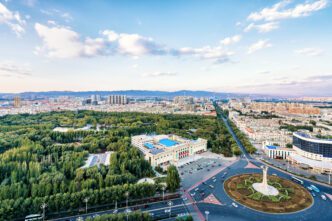The Ontario government is taking significant steps to bolster the province’s economy amid the challenges posed by potential U.S. tariffs. By addressing interprovincial trade barriers and expediting the approval process for new mines in the Northern Ring of Fire region, the government aims to reinforce its economic foundations. Additionally, plans are underway to construct an ambitious tunnel beneath the Toronto-area stretch of Highway 401, which could prove both lengthy and costly.
In a recent Throne Speech, the Progressive Conservative government, led by Premier Doug Ford, outlined its priorities following a third consecutive majority win in the February 27 election. The government highlighted its commitment to lowering Ontario’s interprovincial trade barriers and designating the Ring of Fire as a region of strategic importance to the province’s economic and security interests.
The speech, delivered by Lieutenant-Governor Edith Dumont in the Legislature, warned of the economic challenges posed by U.S. President Donald Trump, who has openly targeted Ontario’s economy and national sovereignty. Despite these challenges, the government pledged that Canada would never become the 51st state and emphasized the importance of maintaining sovereignty.
In response to the uncertainty created by U.S. policies, Ontario has announced an $11-billion relief package, primarily consisting of a six-month deferral of various provincial business taxes. While promoting closer cooperation with the U.S. through the “Fortress Am-Can” vision, the speech underscored the need for Ontario and Canada to reduce reliance on an unpredictable partner, advocating for tough decisions ahead.
Ontario reaffirmed its support for the electric vehicle and battery industry, highlighting substantial investments made by major automakers, amounting to $46-billion in new ventures. The speech stressed the expectation that future federal governments continue to support the industry, a stance criticized by Conservative Leader Pierre Poilievre but previously backed by former Prime Minister Justin Trudeau.
Recent developments include Honda’s $15-billion investment in Ontario to produce electric vehicles and batteries, supported by up to $5-billion in federal and provincial subsidies. This investment marks the largest in Canada’s auto sector history, positioning Ontario as a key player in Honda’s North American electric vehicle strategy. Despite reports suggesting Honda might shift production due to U.S. tariffs, Ontario Premier Doug Ford dismissed these claims as inaccurate.
The Ring of Fire region, located approximately 500 kilometers north of Thunder Bay, is identified as crucial in countering economic threats from the U.S. It holds essential mineral reserves, including cobalt and nickel vital for battery production. The government plans to accelerate approvals for mining companies meeting high standards, while ensuring necessary consultations with First Nations, a move the Chiefs of Ontario emphasize must respect First Nations’ rights.
Further efforts to streamline processes include reducing red tape in environmental assessments and refining conservation practices and species-at-risk regulations. The government also reiterated its commitment to a new tunnel expressway and transitway under Highway 401, part of a broader $200-billion infrastructure plan, despite expert concerns about the tunnel’s potential cost.
Your Takeaway
The actions outlined by the Ontario government could significantly impact the province’s residents and businesses. By addressing trade barriers and fostering the mining industry in the Northern Ring of Fire, Ontario aims to strengthen its economic resilience, potentially leading to job creation and enhanced regional development. The focus on reducing dependency on the U.S. might also encourage diversification and innovation within local industries.
The commitment to supporting the electric vehicle sector highlights Ontario’s dedication to sustainable economic growth, aligning with global trends towards greener technologies. This could lead to increased investment opportunities and collaboration with international automotive companies, boosting the province’s industrial capabilities.
Infrastructure development, such as the proposed Highway 401 tunnel, promises to improve transportation efficiency, facilitating the movement of people and goods across the region. However, the financial implications of such projects warrant careful consideration to ensure fiscal responsibility and long-term benefits for Ontario’s citizens.








